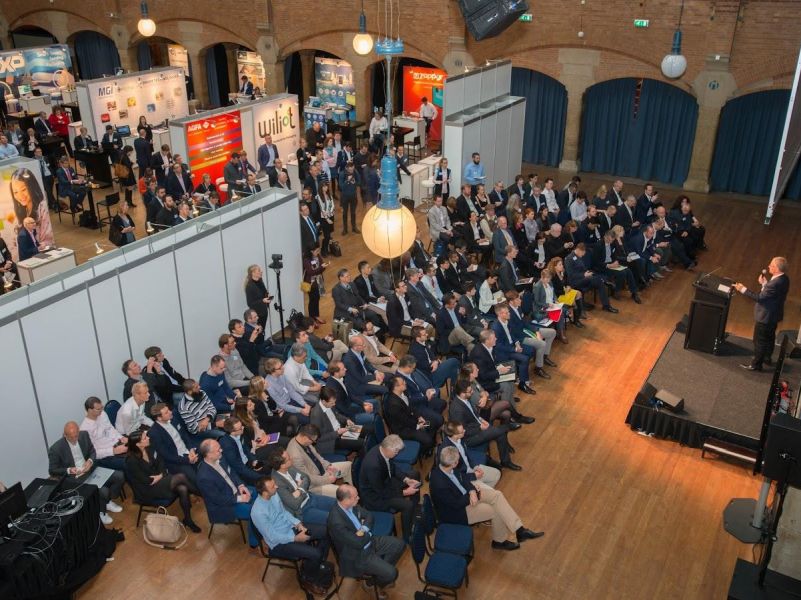Eef de Ferrante, Director of AIPIA, the Active & Intelligent Packaging Industry Association, answers our questions about the latest trends in smart packaging.
AIPIA’s international members include renown FMCG brands, research institutions, technology providers and, of course, packaging companies from around the world. The AIPIA congresses offer innovative formats, exciting speeches and a high-quality exhibition. They are the perfect events to learn more about latest packaging trends and evolving solutions.
Eef de Ferrante: Well, the overall objective is to add value for both the Brand and the consumer. Packaging’s primary aim has always been to protect, preserve and promote the product inside. The ways this can be achieved are greatly enhanced by Smart Packaging. So, for example, packaging trends include Track & Trace, anti counterfeit and anti tamper features, product authentication and provenance, extending shelf life, reducing food waste and consumer engagement.
Consumers want to know more about the products they buy in terms of sustainability and ethical sourcing. So Smart Packaging gives Brands a route to offering this information. But also offers add-ons, such as loyalty and discount services through a simple NFC tag or data code for their smartphone. Smart Packaging can become the most effective marketing tool for both Brand and Retailer. And a huge source of information for them and the consumer.
Well, adding features to a pack costs money. So who pays? Also, these features need to be explained and their value to the consumer thoroughly understood. That will take time. So far very few mass roll outs of Smart Packaging can be demonstrated. It has rather been used for campaigns or carefully targetted products (such as baby infant formulas or high value alcohol products.)

Smart packaging is perfect for high value items!
It will change as the cost of the features come down and the relevance of the things they offer (provenance, compliance) grows.
Another challenge is that some of these products make the packaging harder to recycle. In fact more and more Smart packaging is becoming recyclable (paper-based RFID tags, OLED, graphine conductive inks). Let’s always keep in mind, that wasting the product (usually food) might cause far more environmental damage than the packaging does. So its a trade off in some respects.
There is an almost pathologic focus on sustainability. Due to both political and media pressure as well as consumer awareness of environmental issues.
This means, that a lot of the development budgets are being spent in that area, at the expense of every other innovation. This is ironic as many of the packaging trends provide waste reduction or aid recycling.
With more sustainable effects than the fixation on single use plastics or not using plastics at all.
Eef de Ferrante: Well, these days AIPIA likes to call everything Smart Packaging. Often there are combinations of different technologies or features, which can operate as both active and intelligent.
And it does depend on who you talk to.
But, put simply, Active packaging works on the product and Intelligent packaging works on the consumer. Let me explain. Active packaging contains elements, which cause the product to stay fresher for longer, become more resistant to microbial growth or checks the condition of that product along the supply chain. Whereas an RFID Tag, NFC tag or a data code for scanning provides information to the retailer/consumer/logistics provider. So we deem that as Intelligent.
A good example of the crossover is, when a condition monitoring feature (active) on a meat pack also includes an interactive label which can change the information it displays as the time elapses (intelligent.)
There is a good graphic explaining this on the AIPIA website.
Eef de Ferrante: AIPIA notes several trends: One is the demand from consumers to know more about the product and its origin. Here is, where something like Blockchain comes into its own. But the pandemic has also highlighted the need for safe and hygenic food distribution. So to some extend the plastics pack has proven its worth. Smart packaging provides a clear and easily accessible record of a products journey and can help it stay fresher for longer.
Obviously anti counterfeiting measures, avoidance of market diversion (gray market) are important for pharmaceuticals, wines & spirits, tobacco and high value items. We are seeing wider adoption of Smart Packaging in all these sectors. In particular in the EU there is a major roll out of traceability coding on individual packets of cigarettes, involving billions of packets. So, if proof was needed of the scalability of Smart tech, then this is certainly it!
But Brands are still particularly interested in the consumer engagement aspects of Smart Packaging. How it helps them form a closer relationship with the consumer and keeps the – often traditional – product ‚fresh‘ in the consumer experience.

Smart packaging enables customer engagement – right off the product and its label
At AIPIA we are also seeing a welcome increase in Active technologies to help extend shelf life of foods. I am certain this is due to concerns over food safety, as people going out to shop less often.
Of course the biggest focus will be on supply chain monitoring and security as the world start to move billions of doses of vaccine around the planet. There is a clear need for the safeguards Smart Packaging can offer in this area.
Eef de Ferrante: There are several major successful projects: I mentioned earlier the EU wide tracking of cigarettes by Dents, this is a major step in securing tax revenues, avoiding counterfeits and avoiding market diversion.
Another excellent example is the track & trace of infant formula made for the Chinese market by FrieslandCampina. There are serious problems with counterfeiting of this kind of product in China. By working with our member Kezzler the dairy giant has come up with an effective, low cost solution. Danone has also used technology with QR codes to authenticate its infant formula in this market.
From packs to help visually impaired consumers through clever devices to help patients comply with their medical regime to wacky fun AR experiences to engage Generation Z, there is something for everyone.
Rather than enumerate the many successful applications of Smart Packaging here, l suggest a visit to the AIPIA website News section. It will give anyone interested a very clear picture of packaging trends, the diverse range of products and Brands benefiting from the many solutions now available.
Eef de Ferrante: Well, becoming a member of AIPA or signing up to the free newsletter will open a window onto the Smart Packaging trends. To go deeper, I recommend attending our Congress and other events. There is no size barrier to becoming an active participant in this sector. Many of the provider companies are small and new to packaging. All our events will be Virtual in 2021 and we have just announced our Global Program for next year.

In 2018 the AIPIA Congress took place “live” in Amsterdam, currently the events are virtual
For start-up Brands utilization of Smart Packaging is a great way to differentiate their products. It helps to compete with the bigger Brands, who have more marketing clout. In fact, we always say that Smart Packaging can be the most effective (and cheapest) marketing tool at your disposal.
Most of the Smart Packaging technologies are within reach of everyone, who wants to use them. There are often alternatives, depending on what you want to achieve. So it is well worth joining the AIPIA ecosystem to see what is available and compare.
There is so much innovation going on! It is clearly a good time to think about and use Smart Packaging. There is plenty of investment in technology providers and l have said before Smart Money is following Smart Packaging. More than ever this seems to be the case!
Dear Eef, thank you for the conversation! As AIPIA member and regular participant in AIPIA congresses, we think:
Our smart audio product label solves the complaint No 1 about product labels and packaging: They are too hard to read!…
read moreAcademically evaluated, rigorously tested, many times awarded and successfully in use:
read moreAudible manuals have many advantages over printed editions
read moreFind out how Siri and Alexa promote sustainability in marketing
read moreHow to reach people with reading difficulties:
read moreWhy the generation 50+ is such an important target group
read moreFind out why smart solutions are a must for pharmaceutical packaging
read more